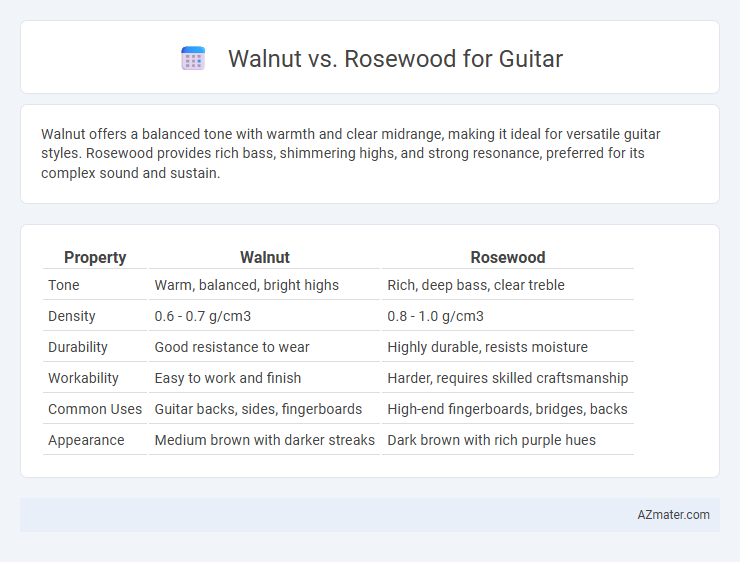Walnut offers a balanced tone with warmth and clear midrange, making it ideal for versatile guitar styles. Rosewood provides rich bass, shimmering highs, and strong resonance, preferred for its complex sound and sustain.
Table of Comparison
| Property | Walnut | Rosewood |
|---|---|---|
| Tone | Warm, balanced, bright highs | Rich, deep bass, clear treble |
| Density | 0.6 - 0.7 g/cm3 | 0.8 - 1.0 g/cm3 |
| Durability | Good resistance to wear | Highly durable, resists moisture |
| Workability | Easy to work and finish | Harder, requires skilled craftsmanship |
| Common Uses | Guitar backs, sides, fingerboards | High-end fingerboards, bridges, backs |
| Appearance | Medium brown with darker streaks | Dark brown with rich purple hues |
Introduction to Walnut and Rosewood Tonewoods
Walnut offers a balanced tonal profile with a strong midrange, bright highs, and warm lows, making it favored for its rich, articulate sound and attractive grain patterns. Rosewood is prized for its deep, resonant bass, complex overtones, and smooth sustain, commonly used for guitar backs and sides due to its excellent projection and tonal depth. Both tonewoods significantly influence a guitar's sound character, with walnut providing clarity and rosewood delivering warmth and richness.
Historical Use in Guitar Manufacturing
Walnut and rosewood have both played significant roles in guitar manufacturing, with rosewood traditionally favored for its rich tonal qualities and durability in fingerboards and backplates since the early 19th century. Walnut, while less common, has been used historically for guitar bodies due to its balanced tone and attractive grain patterns, particularly in American and British guitars during the mid-20th century. Rosewood's extensive use is linked to its strong resonance and ability to enhance bass response, whereas walnut offers a unique aesthetic and warmth, influencing the sound profile of vintage and custom instruments.
Appearance and Aesthetics Comparison
Walnut guitars exhibit a rich, warm brown color with subtle, straight grain patterns that offer a classic and understated elegance. Rosewood, on the other hand, boasts a darker, deeper hue ranging from brown to purplish-black with intricate, swirling grain designs that provide a more exotic and luxurious look. The visual contrast between walnut's smooth, uniform texture and rosewood's complex, vibrant grain makes rosewood a preferred choice for players seeking a striking, ornamental finish.
Tonal Characteristics: Walnut vs Rosewood
Walnut guitars deliver a balanced tonal profile with pronounced midrange clarity, warm lows, and bright highs, making them versatile across genres. Rosewood offers rich, complex overtones with deep bass response and shimmering treble, enhancing sustain and harmonic depth. The tonal characteristics of walnut emphasize clarity and punch, while rosewood provides a smoother, more resonant sound ideal for fingerstyle and intricate playing.
Weight and Density Differences
Walnut guitars are generally lighter with a density ranging from 0.55 to 0.65 g/cm3, offering a balanced tone and comfortable playability, while rosewood is denser, approximately 0.80 to 0.85 g/cm3, contributing to a richer, warmer sound with enhanced sustain. The weight difference impacts the instrument's resonance and player fatigue during extended sessions, making walnut a preferred choice for lightweight preferences. Rosewood's higher density provides greater stability and a more pronounced midrange frequency response, favored in acoustic and electric guitar construction for tonal depth.
Durability and Maintenance
Walnut offers moderate durability with a balanced hardness that resists dents and scratches better than softer woods, making it easier to maintain over time. Rosewood ranks higher in durability due to its dense, oily grain which provides excellent resistance to wear and moisture, requiring less frequent conditioning to preserve its structural integrity. Regular cleaning and occasional oiling are essential for both woods, but rosewood's natural oils reduce the need for intensive upkeep compared to walnut.
Sustain and Projection Qualities
Walnut guitars offer a balanced sustain with warm midrange tones and moderate projection, making them ideal for versatile playing styles. Rosewood is renowned for its superior sustain, rich low-end resonance, and strong projection, favored in acoustic guitars for its deep, complex tonal qualities. Guitarists seeking powerful projection and extended sustain often prefer rosewood, while walnut provides a more focused tone with clear articulation.
Price and Availability
Walnut guitars typically offer a more affordable price point compared to rosewood, making them accessible for a broader range of players. Rosewood is rarer and often subject to export restrictions, which increases its cost and limits availability in the market. Buyers looking for premium tonewoods must weigh rosewood's superior resonance against walnut's cost-effectiveness and easier procurement.
Environmental and Ethical Considerations
Walnut and rosewood differ significantly in environmental and ethical impact, with rosewood facing stricter regulations due to its classification under CITES Appendix II, limiting its trade to protect endangered species. Walnut is more sustainably sourced and widely available, making it a preferable choice for eco-conscious guitar makers aiming to reduce deforestation and illegal logging. Choosing walnut supports responsible forestry practices, while rosewood's scarcity and regulatory challenges raise ethical concerns in the guitar manufacturing industry.
Choosing the Right Wood for Your Playing Style
Walnut offers balanced tonal warmth with clear midrange and crisp attack, making it ideal for fingerpicking and blues styles, while rosewood provides rich, complex overtones and enhanced sustain favored in jazz and classical genres. Walnut's moderate density adds bright resonance and dynamic responsiveness, suitable for versatile playing across genres. Rosewood's natural oil content contributes to a smooth feel and deeper bass response, supporting intricate chord voicings and melodic solos.

Infographic: Walnut vs Rosewood for Guitar
 azmater.com
azmater.com